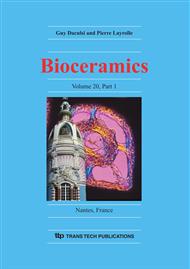p.551
p.555
p.559
p.563
p.567
p.571
p.575
p.581
p.585
Apatite-Forming Ability of Organic-Inorganic Hybrids Prepared from Calcium Silicate and Glucomannan
Abstract:
So-called bioactive ceramics are used for bone-repairing owing to attractive features such as direct bone-bonding in living body. However, there is limitation on clinical applications due to their inappropriate mechanical properties performances such as higher brittleness and lower fracture toughness than natural bone. To overcome this problem, hybrid materials have been developed by modification of calcium silicate, that is basic component of bioactive ceramics, with organic polymer. It is known that bioactive ceramics bond to bone through bone-like apatite layer which is formed on their surfaces by chemical reaction with body fluid. We attempted preparation of bioactive organic-inorganic hybrids from Glucomannan that is a kind of complex polysaccharide, and calcium silicate. Hybrids were prepared from glucomannan and tetraethoxysilane (TEOS). They were treated with 1M (=mol·m-3) CaCl2 aqueous solution for 24 hours. Then ability of apatite formation on the hybrids was examined in vitro using simulated body fluid (SBF, Kokubo solution). Surface structure of the specimens was examined by thin-film X-ray diffraction (TF-XRD), scanning electron microscopic (SEM) observation. The hybrids with TEOS:Glucomannan= 1:1 to 4:1 in mass ratio formed the apatite in SBF within 3 or 7 d, when they were previously treated with CaCl2 solution.
Info:
Periodical:
Pages:
567-570
Citation:
Online since:
November 2007
Authors:
Price:
Сopyright:
© 2008 Trans Tech Publications Ltd. All Rights Reserved
Share:
Citation:


